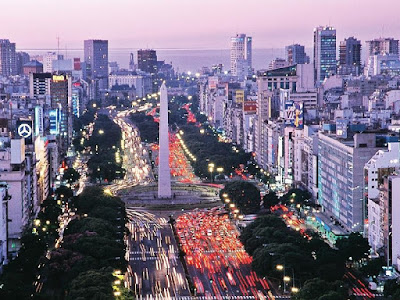Buenos Aires is the capital and largest city of Argentina, and the second-largest metropolitan area in South America. It is located on the western shore of the estuary of the Río de la Plata, on the continent's southeastern coast. The Greater Buenos Aires conurbation, which also includes several Buenos Aires Province districts, constitutes the third-largest conurbation in Latin America, with a population of around fifteen and a half million.
The city of Buenos Aires is neither part of Buenos Aires Province nor the Province's capital; rather, it is an autonomous district. In 1880, after decades of political infighting, Buenos Aires was federalized and removed from Buenos Aires Province. The city limits were enlarged to include the towns of Belgrano and Flores; both are now neighborhoods of the city. The 1994 constitutional amendment granted the city autonomy, hence its formal name: Ciudad Autónoma de Buenos Aires (Autonomous City of Buenos Aires). Its citizens first elected a Chief of Government (i.e. Mayor) in 1996; before, the Mayor was directly appointed by the President of the Republic.
The Battle of the River Plate took place in waters by Buenos Aires in December 1939, making it the first naval battle in the Second World War, and the first one of Battle of the Atlantic
Buenos Aires is, along with Mexico City and São Paulo, one of the three Latin American cities considered an 'alpha city' by the study GaWC5. Buenos Aires' quality of life was ranked 81st in the world and one of the best in Latin America in 2012, with its per capita income among the three highest in the region.[8][9] It is the most visited city in South America (ahead of Rio de Janeiro) and the second most visited city across Spanish Latin America (behind Mexico City). It is also one of the most important, largest and most populous of South American capitals, often referred to as the Paris of Americas.
Buenos Aires is a top tourist destination, and is known for its European-style architecture[13] and rich cultural life, with the highest concentration of theaters in the world. Buenos Aires held the 1st Pan American Games in 1951 as well as hosting two venues in the 1978 FIFA World Cup. Buenos Aires will host the 2018 Summer Youth Olympics.
People from Buenos Aires are referred to as porteños (people of the port). The city is the birthplace of the current pope, Francis (former Archbishop of Buenos Aires), and of Queen Máxima of the Netherlands. Buenos Aires defines itself as a multicultural city, being home to multiple ethnic and religious groups. Also, several languages are spoken in the city in addition to Spanish, contributing to its culture and the dialect spoken in the city and in some other parts of the country. This is because in the last 150 years the city, and the country in general, has been a major recipient of millions of immigrants from around the world, especially from Europe, Asia and Latin America, making it a melting pot where several ethnic groups live together and being considered as one of the most diverse cities in Latin America.
The original name was given by the Spanish sailors that arrived in the River de la Plata, by the blessings of the "Santa Maria de los Buenos Aires", the "Holy Virgin Mary of the Good Winds" that gave them the good winds to reach the coast of what is today the city of Buenos Aires. In the first foundation of Buenos Aires, Pedro de Mendoza called the city "Holy Mary of the Fair Winds", a name chosen by the chaplain of Mendoza's expedition, a devotee of the Virgin of Buen Ayre. Mendoza’s settlement soon came under attack by indigenous people, and was abandoned in 1541.
For many years, the name was attributed to Sancho del Campo, who is said to have exclaimed: How fair are the winds of this land!, as he arrived. But Eduardo Madero, in 1882 after conducting extensive research in Spanish archives, ultimately concluded that the name was closely linked with the devotion of the sailors to Our Lady of Buen Ayre.
A second (and permanent) settlement was established in 1580 by Juan de Garay, who sailed down the Paraná River from Asunción (now the capital of Paraguay). Garay preserved the name chosen by Mendoza, calling the city Ciudad de la Santísima Trinidad y Puerto de Santa María del Buen Aire ("City of the Most Holy Trinity and Port of Saint Mary of the Fair Winds"). The short form "Buenos Aires" became the common usage during the 17th century. The usual abbreviation for Buenos Aires in Spanish is Bs.As. It is common as well to refer to it as "B.A." or "BA" /ˌbiːˈeɪ/ bee-ay).
The Catalan missionaries and Jesuits that arrived under the Spanish Crown, recorded under the archives of Aragonese when they conquered Cagliari, Sardinia from the Pisans in 1324, they established their headquarters on top of a hill that overlooked the city.[24] The hill was known to them as Buen Ayre (or "Bonaria" in the local language), as it was free of the foul smell prevalent in the old city (the castle area), which is adjacent to swampland. During the siege of Cagliari, the Aragonese built a sanctuary to the Virgin Mary on top of the hill. In 1335, King Alfonso the Gentle donated the church to the Mercedarians, who built an abbey that stands to this day. In the years after that, a story circulated, claiming that a statue of the Virgin Mary was retrieved from the sea after it miraculously helped to calm a storm in the Mediterranean Sea. The statue was placed in the abbey. Spanish sailors, especially Andalusians, venerated this image and frequently invoked the "Fair Winds" to aid them in their navigation and prevent shipwrecks. A sanctuary to the Virgin of Buen Ayre would be later erected in Seville.










0 Comments